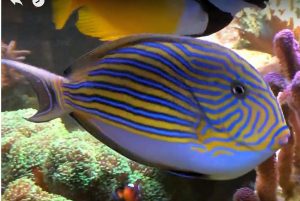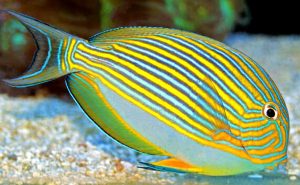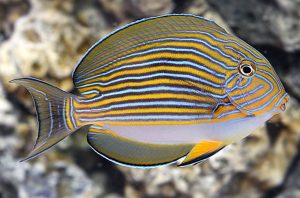The Clown Tang (Acanthurus lineatus) known to tropical fish keeping enthusiasts as the Clown Surgeonfish, Lined Surgeonfish, Striped Tang, Pyjama Tang, Striped Surgeonfish, Zebra Surgeonfish or Blue Banded Surgeonfish is native to the Indo-Pacific and ranges from East Africa (including the Mascarene Islands) to the Hawaiian, Marquesas and Tuamoto islands, north to Japan, and south to the Great Barrier Reef and New Caledonia.
The Clown Tang is a strong, active swimmer that is continually in motion. They gravitate toward wild reefs with strong turbid currents, and like most Tangs are aggressive and territorial with members of their species. Clown Tangs will even lash out at similar looking Tangs during territorial conflicts.
Clown Tangs are a benthopelagic diurnal species that are normally encountered by divers in small to medium schools swimming in turbid surge zones of the seaward reefs of their range, at depths down to about 50 feet. Juvenile Acanthurus lineatus are secretive, much more solitary, and are are normally found among rubble in shallower water from 3 to 10 feet deep, where they can easily take shelter from predators.
Clown Tangs are herbivores that control well defined feeding territories. The largest male in a harem of females will normally take control the harem as well as the feeding territory.
The Clown Tang has a broad, flat shaped body, a short snout with a small mouth, and a long continuous dorsal fin that extends from the top of the head to the forked caudal fin.
The top three quarters of the body has alternating horizontal blue with black edged striping on a bright yellow to orange background that extends from the head to the tail. The lower quarter of the body is a bluish white to pale purple color. The forked caudal fin is edged with black piping and has an asymmetrical blue and yellow pattern with broad separations between the lines.
The bodies of juveniles are deeper than the bodies of adult individuals. Females are slightly larger than males.
The Clown Tang is best housed in a mature FOWLR or reef aquarium of at least 250 gallon capacity with plenty of live rock with mature algae growth for them to feed upon; arranged into caves, crevices, and overhangs for them to hide among when they feel threatened. They need plenty of open water free swimming space to accommodate their need to swim and explore, which requires a longer style tank.
Acanthurus lineatus need pristine, highly oxygenated water, and a strong turbid current in the tank to replicate their natural environment. They are sensitive to water changes and the build up of toxic contaminants. An excellent quality reef filtration system with a protein skimmer and several power heads
strategically placed in the tank should keep them healthy and happy.
Clown Tangs are completely reef safe and will ignore coral polyps, ornamental clams, and invertebrates. They are active foragers that love eating filamentous algae. Although they do occasionally feed on crustaceans, their dietary habitats will help keep your reef tank vibrant and clean.
Because of their aggressive nature and high cost, it is best to keep only one tang in a FOWLR or reef system. Coexistence is possible as juveniles, but unlikely as adults. Generally, juvenile specimens are relatively docile, but once they reach about 6 inches in length, they become more and more aggressive. The aggressiveness increases as the fish fully mature into adulthood.
It is virtually impossible to breed the Clown Tang in a home aquarium environment. They need a huge amount of space to live together, let along spawn.
In the wild, Clown Tangs live in social structure of one dominant male that protects a harem of multiple females. They are broadcast spawners that form large spawning aggregations, but spawn in pairs. Spawning activity occurs during full moon periods.
Courtship normally takes place throughout the day at various times. Although actual spawning can occur from mid day throughout the afternoon and is often confined to ebb tides, it generally peaks during the morning hours. The male and female spiral upwards towards the surface and release their eggs and sperm into the water column. The fertilized eggs have a minute droplet of oil in them that allows them to float on the surface until they hatch out into small larvae. The tiny larvae develop among the floating plankton until they become mature enough to swim to a reef and begin life as a juvenile Clown.
Clown Tangs are herbivorous foragers that in their natural habitat graze on algae and small crustaceans throughout the day.
In an aquarium environment, they require plenty of algae growth live rock to graze on during the day along with a variety of plant based foods like chopped leafy greens, zucchini, Nori (presented on a veggie clip or tucked in between some live rock), and occasional meaty offerings of brine shrimp, mussels, Mysis shrimp, and blood worms. Feeding them meaty proteins will help Clown Tangs maintain their bright colors.
Sea Veggies, Seaweed Salad, and Ocean Nutrition are also good preparations that are easy to use. Feed them at least 3 times per week.
Note: Because all Clown Tangs are wild caught and prefer grazing across reefs, new specimens will often refuse to eat when first introduced into the aquarium. Hold off feeding them meaty protein foods until they are eating herbivore preparations well.
The Clown Tang (Acanthurus lineatus) is a high maintenance species that may not be suitable for all tropical fish keeping enthusiasts. They are available from marine aquarium stores and online from a variety of wholesalers, retailers, and collectors at the following approximate purchase sizes: Small: 1-1/2″ to 2-1/4″; Small/Medium: 2-1/4″ to 3-1/4″ Medium: 3-1/4″ to 4-1/4″. Expect to pay $89.99 for a small fish from Sri Lanka to around $495.00 for a large specimen of 9 inches or more.
Minimum Tank Size: 250 gallons
Aquarium Type: Reef or FOLR
Care Level: Difficult
Temperament: Semi Aggressive
Aquarium Hardiness: Hardy once acclimated
Water Conditions: 72-85° F, dKH 8-12, pH 8.1-8.4, sg 1.020-1.025
Max. Size: 14″
Color Form: Blue, Orange, Yellow
Diet: Herbivore
Compatibility: Reef Ok
Origin: Eastern and Western Pacific Ocean, Hawaii
Family: Acanthuridae
Lifespan: 25 – 30 years
Aquarist Experience Level: Expert




